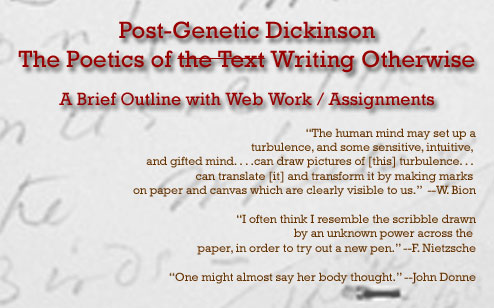

2. Since Dickinson did not date her writings, changes in her handwriting have often been used to date Compose--visually, verbally--the narrative of Dickinson's hands by following both her rough-copy hand and her fair-copy hand chronologically across the archive of her complete writings. What changes occur in the hand? Repeat this process focusing on specific letter forms (T, t, S, s, U, u, O, o). Identify significant changes in letter forms, in the linking and unlinking of letters, and in the positions of ascenders and descenders, and test the changes you identify against the chronological arrangement of the poems in Thomas H. Johnson's The Poems of Emily Dickinson and R. W. Franklin's The Manuscript Books of Emily Dickinson.
3. Compose--visually, verbally--the narrative of Dickinson's hands by following her hand across one group of documents--one fascicle, one "book" of letters to a specific addressee--say, Susan Gilbert Dickinson or Thomas Wentworth Higginson, the late fragments. Note all changes/variations in the hand and attempt to account for them--biographically and aesthetically. What do the hands reveal about Dickinson's life and writing process that the text does not as fully reveal?
4. Follow--and document the path of--the hands of Dickinson's earliest readers, editors, censors across the archive of her complete writings. Identify the "alien" hands (and the panoply of instruments) responsible for the marks/cuts and create a "library" of the different scribal practices associated with the different readerly, editorial, and censorial hands. In what sense do these "hands" aim to transform the bodies of Dickinson's manuscripts into what Michel de Certeau called "the writing machine of the law--the mechanical system of a social articulation" (The Practice of Everyday Life)?
5. Philip Hamerton wrote in The Graphic Arts (1882): "All writing, whether careful, or careless, is drawing of some kind.. . .Rapid handwriting is not merely like sketching, it is sketching. The same strong marks of idiosyncrasy which are to be found in the sketches of artists exist in handwriting, and there is the most various beauty in handwriting" (13). Consider the boundaries between writing and drawing in Dickinson's textual productions. What writing manuals would Dickinson have used in school and how do these manuals address the relation between writing and sketching?
6. "A series of articulated operations (gestural, mental)--that is what writing is" (de Certeau, The Practice of Everyday Life). Build a rich and deep archive of Dickinson's scribal practices (additions, deletions, interlineations, underlinings, dashes, quotation marks, instances of cross writing, etc.). Consider and test various ways of representing/encoding these scribal practices. Include examples of different encoding schemas in your file.
7. Focus on the ways in which Dickinson used the different zones (recto, verso, fold, edge, seal, etc.) of a given manuscript or group of manuscripts in order to investigate the relationship between her messages and her medium. (An interesting example to begin with would be A 636 and the other documents in the A 636 constellation.)
8. Create a library in which you "collect" and analyze all of the materials of writing Dickinson used--papers, pens, inks, pencils, scissors, etc. Your virtual library may resemble an artist's catalog.
9. Build a site focused on more or more related document clusters. See Web 1: Document Constellations Overview for details.